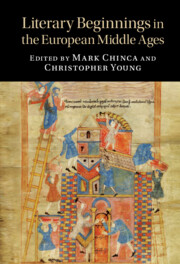Book contents
- Literary Beginnings in the European Middle Ages
- Cambridge Studies in Medieval Literature
- Literary Beginnings in the European Middle Ages
- Copyright page
- Contents
- Contributors
- Acknowledgments
- Foreword
- Chapter 1 Introduction
- Chapter 2 Scandinavia
- Chapter 3 Irish and Welsh
- Chapter 4 English
- Chapter 5 Spain
- Chapter 6 French
- Chapter 7 Dutch
- Chapter 8 Occitan
- Chapter 9 German
- Chapter 10 Italian
- Chapter 11 Czech and Croatian
- Chapter 12 Greek
- Chapter 13 East Slavonic
- Afterword
- Index
- Cambridge Studies in Medieval Literature
Foreword
Published online by Cambridge University Press: 11 August 2022
- Literary Beginnings in the European Middle Ages
- Cambridge Studies in Medieval Literature
- Literary Beginnings in the European Middle Ages
- Copyright page
- Contents
- Contributors
- Acknowledgments
- Foreword
- Chapter 1 Introduction
- Chapter 2 Scandinavia
- Chapter 3 Irish and Welsh
- Chapter 4 English
- Chapter 5 Spain
- Chapter 6 French
- Chapter 7 Dutch
- Chapter 8 Occitan
- Chapter 9 German
- Chapter 10 Italian
- Chapter 11 Czech and Croatian
- Chapter 12 Greek
- Chapter 13 East Slavonic
- Afterword
- Index
- Cambridge Studies in Medieval Literature
Summary
Giambattista Vico’s maxim – ‘Doctrines must take their beginning from that of the matters of which they treat’ – offers sound advice for studying emerging literatures. Unfortunately, medieval studies did not choose to heed this counsel during the nineteenth and much of the twentieth centuries. Vainly seeking literary origins, medievalists focused on theories rather than on artefacts themselves – their material nature and sociohistorical context. They erred in not recognizing the indissoluble bond between emergent vernacular languages, historical context, and the literary expressions that gave them shape and identity. The DNA of literary artefacts reveals temporally sensitive components – language, narrative form, and consciousness of social, linguistic, and cultural heritage – in evolutionary flux. Unsurprisingly, then, European medieval literatures evolved under widely varied conditions. For example, northwest Europe was the seat of Charlemagne’s Empire from the ninth to the eleventh centuries. Early on, the Empire divided linguistically between Old Gallo-Romance on the left bank of the Rhine, and Old Franconian on the right. Soon thereafter, we find political and literary documents written in those vernaculars. Two examples offer enlightenment: the ‘Strasbourg Oaths’ (842 CE), and Valenciennes 150, a ninth-century manuscript containing among the earliest literary works in Old Gallo-Romance and Old Franconian.
Keywords
- Type
- Chapter
- Information
- Literary Beginnings in the European Middle Ages , pp. 1 - 11Publisher: Cambridge University PressPrint publication year: 2022



